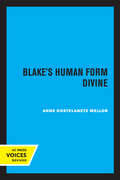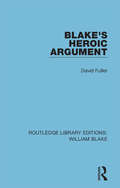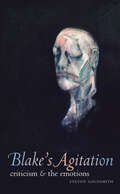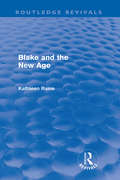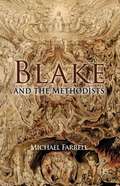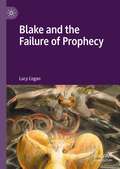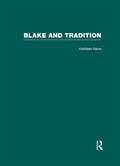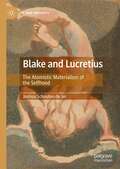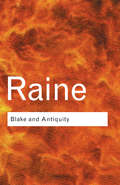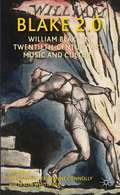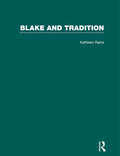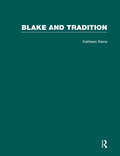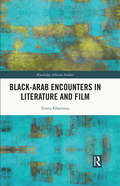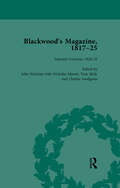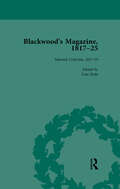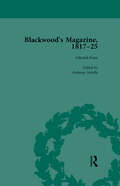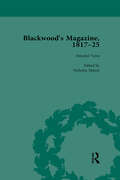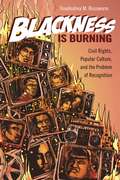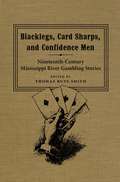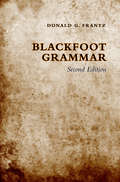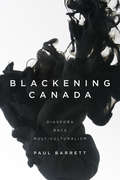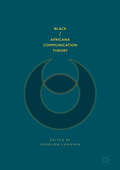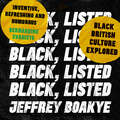- Table View
- List View
Blake's Human Form Divine
by Ann K. MellorThis title is part of UC Press's Voices Revived program, which commemorates University of California Press’s mission to seek out and cultivate the brightest minds and give them voice, reach, and impact. Drawing on a backlist dating to 1893, Voices Revived makes high-quality, peer-reviewed scholarship accessible once again using print-on-demand technology. This title was originally published in 1974.
Blake's Heroic Argument (Routledge Library Editions: William Blake #2)
by David FullerFirst published in 1988, this book is a study of all Blake’s work in illuminated printing. It traces in particular, the development of his ideas on politics, religion, sexuality, and the imagination. There are substantial sections on some of Blake’s best-known works, including the Marriage of Heaven and Hell, and the Songs of Innocence and Experience, and full critical essays on the Four Zoas and Jerusalem. The book describes the historical contexts of Blake’s work, and sets it in relation to the political controversies of his age as these are reflected in the writings of Burke, Paine and Mary Wollstonecraft. It discusses the relationships of text and design in Blake, the characteristic verbal textures and rhythms of his longer poems, some influences on his thought, and developing structure of his personal myth and its relationship to other mythologies. The opening chapter discusses areas of fundamental disagreement with some of the main approaches to Blake whilst the final chapter discusses literary theory and the practice of criticism, arguing for an open and explicit involvement of personal experience and values and a more creative use of form in critical writing.
Blake's Agitation: Criticism and the Emotions
by Steven GoldsmithSince the Romantic period, the critical thinker's enthusiasm has served to substantiate his or her agency in the world.Blake’s Agitation is a thorough and engaging reflection on the dynamic, forward-moving, and active nature of critical thought. Steven Goldsmith investigates the modern notion that there’s a fiery feeling in critical thought, a form of emotion that gives authentic criticism the potential to go beyond interpreting the world. By arousing this critical excitement in readers and practitioners, theoretical writing has the power to alter the course of history, even when the only evidence of its impact is the emotion it arouses. Goldsmith identifies William Blake as a paradigmatic example of a socially critical writer who is moved by enthusiasm and whose work, in turn, inspires enthusiasm in his readers. He traces the particular feeling of engaged, dynamic urgency that characterizes criticism as a mode of action in Blake’s own work, in Blake scholarship, and in recent theoretical writings that identify the heightened affect of critical thought with the potential for genuine historical change. Within each of these horizons, the critical thinker’s enthusiasm serves to substantiate his or her agency in the world, supplying immediate, embodied evidence that criticism is not one thought-form among many but an action of consequence, accessing or even enabling the conditions of new possibility necessary for historical transformation to occur. The resulting picture of the emotional agency of criticism opens up a new angle on Blake’s literary and visual legacy and offers a vivid interrogation of the practical potential of theoretical discourse.
Blake and the New Age (Routledge Revivals)
by Kathleen RaineFirst published in 1979, this is a very welcome reissue of Kathleen Raine's seminal study of William Blake - England’s only prophet. He challenged with extraordinary vigour the premises which now underline much of Western civilization, hitting hard at the ideas of a naive materialist philosophy which, even in his own day, was already eating at the roots of English national life. In his insistence that ‘mental things are alone real’, Blake was ahead of his time. Materialist views are now challenged from various quarters; the depth psychologies of Freud and Jung, the study of Far Easter religion and philosophy, the reappraisal of myth and folk lore, the wealth of psychical research have all prepared the way for an understanding of Blake’s thought. We are ready to acknowledge that in attacking ‘the sickness of Albion’ Blake penetrated to the inner worlds of man and explored them in a way that is quite unique. Dr Raine, who has made a long study of Blake’s sources, presents him as a lonely powerful genius who stands within the spiritual tradition of Sophia Perennis, ‘the Everlasting Gospel’. From the standpoint of this great human Norm, our immediate past described by W.B. Yeats as ‘the three provincial centuries’, is a tragic deviation; catastrophic, as Blake believed, in its spiritual and material consequences. Only now do we possess the necessary knowledge to understand William Blake and the ever-growing number of people who turn to him surely justifies his faith in the eternal truths he strove to communicate.
Blake and the Methodists
by Michael FarrellExploring the work of William Blake within the context of Methodism - the largest 'dissenting' religious group during his lifetime - this book contributes to ongoing critical debates surrounding Blake's religious affinities by suggesting that, contrary to previous thinking, Blake held sympathies with certain aspects of Methodism.
Blake and the Failure of Prophecy
by Lucy CoganThis monograph reorients discussion of Blake’s prophetic mode, revealing it to be not a system in any formal sense, but a dynamic, human response to an era of momentous historical change when the future Blake had foreseen and the reality he was faced with could not be reconciled. At every stage, Blake’s writing confronts the central problem of all politically minded literature: how texts can become action. Yet he presents us with no single or, indeed, conclusive answer to this question and in this sense it can be said that he fails. Blake, however, never stopped searching for a way that prophecy might be made to live up to its promise in the present. The twentieth-century hermeneuticist Paul Ricoeur shared with Blake a preoccupation with the relationship between time, text and action. Ricoeur’s hermeneutics thus provide a fresh theoretical framework through which to analyse Blake’s attempts to fulfil his prophetic purpose.
Blake and Tradition (Routledge Library Editions Ser.)
by Kathleen RaineBlake and Tradition is an investigation of the sources of Blake's knowledge of the Neoplatonic and Hermetic tradition and allied currents of thought. The volumes contain what was then new information on Blake's vast fund of exact knowledge in these fields, and Kathleen Raine interprets his works in the light of the ideas that originally inspired and informed them.The core of this important work of scholarship formed the A. W. Mellon Lectures in the Fine Arts in 1962 at the National Gallery of Art in Washington. The expanded, two-volume work was originally published by Routledge & Kegan Paul in 1969.
Blake and Lucretius: The Atomistic Materialism of the Selfhood (The New Antiquity)
by Joshua Schouten de JelThis book demonstrates the way in which William Blake aligned his idiosyncratic concept of the Selfhood – the lens through which the despiritualised subject beholds the material world – with the atomistic materialism of the Epicurean school as it was transmitted through the first-century BC Roman poet and philosopher Lucretius’ De Rerum Natura. By addressing this philosophical debt, this study sets out a threefold re-evaluation of Blake’s work: to clarify the classical stream of Blake’s philosophical heritage through Lucretius; to return Blake to his historical moment, a thirty-year period from 1790 to 1820 which has been described as the second Lucretian moment in England; and to employ a new exegetical model for understanding the phenomenological parameters and epistemological frameworks of Blake’s mythopoeia. Accordingly, it is revealed that Blake was not only aware of classical atomistic cosmogony and sense-based epistemology but that he systematically mapped postlapsarian existence onto an Epicurean framework.
Blake and Antiquity (Routledge Classics)
by Kathleen RaineBlake was a visionary like no other. To some, like William Wordsworth, the only explanation for the remarkable spiritual world Blake witnessed and brought to life in his books was 'insane genius'. Although such a view persisted well into the twentieth century, this is the pivotal work which challenged that perspective and changed forever our understanding of William Blake's genius, placing him in the esoteric tradition. For many this book will be a revelation; for lovers of Blake it is indispensable.
Blake 2.0
by Steve Clark Tristanne Connolly Jason WhittakerBlake said of his works, 'Tho' I call them Mine I know they are not Mine'. So who owns Blake? Blake has always been more than words on a page. This volume takes Blake 2. 0 as an interactive concept, examining digital dissemination of his works and reinvention by artists, writers, musicians, and filmmakers across a variety of twentieth-century media.
Blake & Tradition V2 (Routledge Library Editions Ser.)
by Kathleen RaineFirst published in 2002. This is a collection of topics of A.W.Mellon Lectures of fine Arts stemming from 1962 on the works of Blake. This volume looks at Blake’s work in three discussions; Reason, Perception and ‘What is Man’. Includes poems such as The Tyger, The Ancient Trees and The Sickness of Albion.
Blake & Tradition V1 (Routledge Library Editions Ser.)
by Kathleen RaineFirst published in 2002. This is a collection of topics of A.W.Mellon Lectures of fine Arts stemming from 1962 on the works of Blake. This volume looks at Blake’s work in three sections; ‘The Northern Sun’, ‘The Myth of The Soul’ and ‘Zoas of Physical Life’. Includes works such as ‘Tireil’, Blake’s Cupid and Psyche’ and ‘Enion’
Black–Arab Encounters in Literature and Film (Routledge African Studies)
by Touria KhannousThis book investigates how representations of Black Africans have been negotiated over time in Arabic literature and film. The book offers direct readings of a representative selection of primary texts, shedding light on the divergent ways these authors understood race across different genres, including pre-Islamic classical poetry, polemical essays, travel narratives, novels, and films. Starting with the first recognized Black-Arab poet Antara Ibn Shaddad (580 C.E.) and extending right up to the present day, the works examined illuminate the changes in consciousness that attended Black Africans as they negotiated their position in Arab society. In a twist to Edward Said’s Orientalism, the book argues that scholars in the Middle East and North Africa generated a hierarchical representational discourse themselves, one equally predicated on the Self-Other binary. However, it also demonstrates that Arab racial discourse is not a linear rhetoric but changes according to history, political circumstances, and ideologies such as tribal politics, the Shu’ubiyya movement, nationalism, and imperialism. Blacks and Arabs have had tangled relationships that are based not only on race but also on kinship and solidarity due to trade and other types of connections. Challenging fundamental assumptions of Black Diaspora studies and postcolonial studies, this book will be of interest to scholars of the African diaspora, Arabic literature, Middle East studies, and critical race studies.
Blackwood's Magazine, 1817-25, Volume 6: Selections from Maga's Infancy
by Mark Parker John Strachan Tom Mole Nicholas Mason Anthony JarrellsContextualizes and annotates the influential, scandalous, and entertaining texts which appeared in the Blackwood's Magazine between 1817 and 1825. This title features a detailed general introduction, volume introductions and endnotes, providing the reader with an understanding of the origins and early history of Blackwood's Magazine.
Blackwood's Magazine, 1817-25, Volume 5: Selections from Maga's Infancy
by Mark Parker John Strachan Tom Mole Nicholas Mason Anthony JarrellsContextualizes and annotates the influential, scandalous, and entertaining texts which appeared in the Blackwood's Magazine between 1817 and 1825. This title features a detailed general introduction, volume introductions and endnotes, providing the reader with an understanding of the origins and early history of Blackwood's Magazine.
Blackwood's Magazine, 1817-25, Volume 2: Selections from Maga's Infancy
by Mark Parker John Strachan Tom Mole Nicholas Mason Anthony JarrellsContextualizes and annotates the influential, scandalous, and entertaining texts which appeared in the Blackwood's Magazine between 1817 and 1825. This title features a detailed general introduction, volume introductions and endnotes, providing the reader with an understanding of the origins and early history of Blackwood's Magazine.
Blackwood's Magazine, 1817-25, Volume 1: Selections from Maga's Infancy
by Mark Parker John Strachan Tom Mole Nicholas Mason Anthony JarrellsContextualizes and annotates the influential, scandalous, and entertaining texts which appeared in the Blackwood's Magazine between 1817 and 1825. This title features a detailed general introduction, volume introductions and endnotes, providing the reader with an understanding of the origins and early history of Blackwood's Magazine.
Blackness Is Burning: Civil Rights, Popular Culture, and the Problem of Recognition (Contemporary Approaches to Film and Media Series)
by Treaandrea M. RusswormBlackness Is Burning is one of the first books to examine the ways race and psychological rhetoric collided in the public and popular culture of the civil rights era. In analyzing a range of media forms, including Sidney Poitier’s popular films, black mother and daughter family melodramas, Bill Cosby’s comedy routine and cartoon Fat Albert, pulpy black pimp narratives, and several aspects of post–civil rights black/American culture, TreaAndrea M. Russworm identifies and problematizes the many ways in which psychoanalytic culture has functioned as a governing racial ideology that is built around a flawed understanding of trying to “recognize” the racial other as human. The main argument of Blackness Is Burning is that humanizing, or trying to represent in narrative and popular culture that #BlackLivesMatter, has long been barely attainable and impossible to sustain cultural agenda. But Blackness Is Burning makes two additional interdisciplinary interventions: the book makes a historical and temporal intervention because Russworm is committed to showing the relationship between civil rights discourses on theories of recognition and how we continue to represent and talk about race today. The book also makes a formal intervention since the chapter-length case studies take seemingly banal popular forms seriously. She argues that the popular forms and disreputable works are integral parts of our shared cultural knowledge. Blackness Is Burning’s interdisciplinary reach is what makes it a vital component to nearly any scholar’s library, particularly those with an interest in African American popular culture, film and media studies, or psychoanalytic theory.
Blacklegs, Card Sharps, and Confidence Men: Nineteenth-Century Mississippi River Gambling Stories (Southern Literary Studies)
by Thomas Ruys SmithIn 1836 Benjamin Drake, a midwestern writer of popular sketches for newspapers of the day, introduced his readers to a new and distinctly American rascal who rode the steamboats up and down the Mississippi and other western waterways -- the riverboat gambler. These men, he recorded, "dress with taste and elegance; carry gold chronometers in their pockets; and swear with the most genteel precision.... Every where throughout the valley, these mistletoe gentry are called by the original, if not altogether classic, cognomen of 'Black-legs.'" In Blacklegs, Card Sharps, and Confidence Men, Thomas Ruys Smith collects nineteenth-century stories, sketches, and book excerpts by a gallery of authors to create a comprehensive collection of writings about the riverboat gambler. Long an iconic figure in American myth and popular culture but, strangely, one that has never until now received a book-length treatment, the Mississippi River gambler was a favorite character throughout the nineteenth century -- one often rich with moral ambiguities that remain unresolved to this day.In the absorbing fictional and nonfictional accounts of high stakes and sudden reversals of fortune found in the pages of Smith's book, the voices of canonized writers such as William Dean Howells, Herman Melville, and, of course, Mark Twain hold prominent positions. But they mingle seamlessly with lesser-known pieces such as an excerpt from Edward Willett's sensationalistic dime novel Flush Fred's Full Hand, raucous sketches by anonymous Old Southwestern humorists from the Spirit of the Times, and colorful accounts by now nearly forgotten authors such as Daniel R. Hundley and George W. Featherstonhaugh. Smith puts the twenty-eight selections in perspective with an Introduction that thoroughly explores the history and myth surrounding this endlessly fascinating American cultural icon. While the riverboat gambler may no longer ply his trade along the Mississippi, Blacklegs, Card Sharps, and Confidence Men makes clear the ways in which he still operates quite successfully in the American imagination.
Blackfoot Grammar
by Donald G. FrantzThousands of people in Alberta and Montana speak Blackfoot, an Algonquian language. But the numbers are diminishing and the survival of Blackfoot is in some danger. To help preserve the language while it is still in daily use, Donald G. Frantz and Norma Jean Russell collaborated on the Blackfoot Dictionary, published in 1989 to widespread acclaim and later revised in 1995. Blackfoot Grammar, the companion volume to the dictionary, has now also been updated with a second edition. The changes made to each chapter reflect new approaches refined through years of teaching experience. New chapters on 'Numbers and Enumeration' and 'Translating from English to Blackfoot' have been added, as well as new exercises and two new appendixes describing the phonetics of Blackfoot and the design of the alphabet.This second edition of Blackfoot Grammar will be a welcome update not only for those who wish to learn the language, but for all those with an interest in Native Studies and North American linguistics.
Blackening Canada
by Paul BarrettFocusing on the work of black, diasporic writers in Canada, particularly Dionne Brand, Austin Clarke, and Tessa McWatt, Blackening Canada investigates the manner in which literature can transform conceptions of nation and diaspora. Through a consideration of literary representation, public discourse, and the language of political protest, Paul Barrett argues that Canadian multiculturalism uniquely enables black diasporic writers to transform national literature and identity. These writers seize upon the ambiguities and tensions within Canadian discourses of nation to rewrite the nation from a black, diasporic perspective, converting exclusion from the national discourse into the impetus for their creative endeavours.Within this context, Barrett suggests, debates over who counts as Canadian, the limits of tolerance, and the breaking points of Canadian multiculturalism serve not as signs of multiculturalism's failure but as proof of both its vitality and of the unique challenges that black writing in Canada poses to multicultural politics and the nation itself.
Black/Africana Communication Theory
by Kehbuma LangmiaMost Western-driven theories do not have a place in Black communicative experience, especially in Africa. Many scholars interested in articulating and interrogating Black communication scholarship are therefore at the crossroads of either having to use Western-driven theory to explain a Black communication dynamic, or have to use hypothetical rules to achieve their objectives, since they cannot find compelling Black communication theories to use as reference. Colonization and the African slave trade brought with it assimilationist tendencies that have dealt a serious blow on the cognition of most Blacks on the continent and abroad. As a result, their interpersonal as well as in-group dialogic communication had witnessed dramatic shifts. Black/Africana Communication Theory assembles skilled communicologists who propose uniquely Black-driven theories that stand the test of time. Throughout the volume’s fifteen chapters theories including but not limited to Afrocentricity, Afro-Cultural Mulatto, Venerative Speech Theory, Africana Symbolic Contextualism Theory, HaramBuntu-Government-Diaspora Communications Theory, Consciencist Communication Theory and Racial Democracy Effect Theory are introduced and discussed.
Black, Listed: Black British Culture Explored
by Jeffrey BoakyeAFRO-CARIBBEAN. COLOURED. ETHNIC MINORITY. IMMIGRANT. BAME. URBAN. WOKE. FAM. BLACK.These are just some of the terms being wrestled with in Black, Listed, an exploration of twenty-first century Black identity told through a list of insults, insights and everything in between. Taking a panoramic look at global Black history and contemporary culture, this book investigates the ways in which Black communities (and individuals) have been represented, oppressed, mimicked, celebrated and othered. Part autobiographical musing, part pop culture vivisection, it's a comprehensive attempt to make sense of blackness from the vantage point of the hilarious and insightful psyche of Jeffrey Boakye. PRAISE FOR BLACK, LISTED: 'This book gives a voice to those whose experience is persistently defined, refined and denied by others' David Lammy, Guardian 'A panoramic exploration of black identity' Elle'Urgent, timely reading' AnOther Magazine 'Inventive, refreshing and humorous' Bernardine Evaristo, author of Girl, Woman, Other 'A truly radical book, which manages to be unflinching and constantly entertaining' Caroline Sanderson, The Bookseller
Black, Listed: Black British Culture Explored
by Jeffrey BoakyeGUARDIAN MUST READ BOOKS OF 2019 FINANCIAL TIMES BOOKS TO READ 2019 NEW STATESMAN MUST READS 2019'A truly radical book, which manages to be unflinching and constantly entertaining' CAROLINE SANDERSON, THE BOOKSELLER BOOK OF THE MONTH APRIL 2019'This book gives a voice to those whose experience is persistently defined, refined and denied by others' DAVID LAMMY, GUARDIAN *Who is a roadman really? What's wrong with calling someone a 'lighty'? Why do people think black guys are cool?These are just some of the questions being wrestled with in Black, Listed, an exploration of 21st century black identity told through a list of insults, insights and everything in-between.Taking a panoramic look at global black history, interrogating both contemporary and historical culture, Black, Listed investigates the ways in which black communities (and individuals) have been represented, oppressed, mimicked, celebrated, and othered. Part historical study, part autobiographical musing, part pop culture vivisection, it's a comprehensive attempt to make sense of blackness from the vantage point of the hilarious and insightful psyche of Jeffrey Boakye. Along the way, it explores a far reaching range of social and cultural contexts, including but not limited to, sport, art, entertainment, politics, literature, history, music, theatre, cinema, education and criminal justice, sometimes at the same time.
Black to Nature: Pastoral Return and African American Culture
by Stefanie K. DunningIn Black to Nature: Pastoral Return and African American Culture, author Stefanie K. Dunning considers both popular and literary texts that range from Beyoncé’s Lemonade to Jesmyn Ward’s Salvage the Bones. These key works restage Black women in relation to nature. Dunning argues that depictions of protagonists who return to pastoral settings contest the violent and racist history that incentivized Black disavowal of the natural world. Dunning offers an original theoretical paradigm for thinking through race and nature by showing that diverse constructions of nature in these texts are deployed as a means of rescrambling the teleology of the Western progress narrative. In a series of fascinating close readings of contemporary Black texts, she reveals how a range of artists evoke nature to suggest that interbeing with nature signals a call for what Jared Sexton calls “the dream of Black Studies”—abolition. Black to Nature thus offers nuanced readings that advance an emerging body of critical and creative work at the nexus of Blackness, gender, and nature. Written in a clear, approachable, and multilayered style that aims to be as poignant as nature itself, the volume offers a unique combination of theoretical breadth, narrative beauty, and broader perspective that suggests it will be a foundational text in a new critical turn towards framing nature within a cultural studies context.
